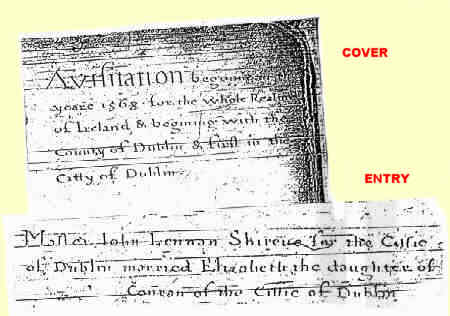
A JOHN LENNAN was Sheriff of Dublin in 1568 and was married to Elizabeth Conran. There is no indication in the manuscript of any children. (Visitation in National Library, Dublin, MS47).
DUBLIN ORIGINS

A JOHN LENNAN was Sheriff of Dublin in 1568 and was married
to Elizabeth Conran. There is no indication in the
manuscript of any children. (Visitation in National
Library, Dublin, MS47).
LENNAN BITS AND PIECES
Lennan, Lennon, Lannan, Lannon, Linnane: Variations of the Gaelic name Ó'Leannáin. Septs (clans) were to be found in, Fermanagh, Mayo and Galway. A number of western O'Leanáins (one 'n') subsequently became Leonards. The Fermanagh sept were "erenaghs" (keepers of holy places) at Lisgoole (near Enniskillen). They were peaceful septs and were noted for their association with the church. No less than six of the sept are mentioned by the Four Masters (one of the earliest Irish manuscripts) and an unusually large number became priests. (During the 14th and 15th century, 6 were priors or canons of Lisgoole). Those of Mayo are a branch of the Uí Fiachrach and were seated in the neighbourhood of Killala, while the Galway family were followers of O'Kelly of Uí Maine. Uí Fiachrach were descendants of Fiachra, son of Eochaidh Muighmheadlionn, King of Ireland in the 4th Century. Fiachra was a brother of the celebrated Niall of the Nine Hostages (who allegedly brought St. Patrick as a slave from Wales) and father of King Dathaí, the last pagan monarch of Ireland. The Uí Fiachrach were divided into two branches, the Uí Fiachrach Aidhne (Southern branch based in Galway) descendants of Eoghan Aidhne, grandson of Dathaí, and the Uí Fiachrach Muaidhe (Northern branch based at Moy, and in present day Mayo and Sligo) descendents of Fiachra son of Dathaí. For a photocopy of the galley proofs of the O'Lennon entry from one of his books supplied by E. McLysaght to my father in the 1950's (the Solicitors' Branch of the Land Commission, where my father worked, and the Irish Manuscripts' Commission were in the same building at 73 Merrion Sq.), together with compliment's slip, click here.
In Heraldry the sept has a shield, motto and crest and are described "the shield argent on a mount in base vert a buck browsing proper", the motto is "Prisco Stirpe Hibernico" (of ancient Irish stock), the crest being the buck browsing proper as on the shield (Source: McLysaght). One should however note that arms are only entitled to be borne by the heirs to the family to which they were granted. The Irish elected chiefs and English primogeniture hereditary systems fundamentally diverged. It is, therefore, unlikely that any of us can claim the 'buck grazing proper' proudly displayed on these pages! The history of the name can be difficult to trace because several families have changed their name to Lennon. (Sources: amalgam of various, including McLysaght). "O'Lennon, Coats of Arms plate 229, O'Leannain, O'Lionnane, Linnane, O'Lennan. The O'Lennon or O'Lennan are recorded as chiefs of a large territory of land in the barony of Tiaquin, which was made into 6 divisions called the '6 sodhrans' of Galway. O'Lennan was given by O'Duignan with MacDaids, O'Scurrys, O'Cashins, O'Gillays and Maginnis, as the chiefs of the territory, after it had been divided. O'Duignan spoke thusly of the 6 sodhrans: 'Let us not shun; Their chieftains are not forgotten, Brave are their predatory hosts; To whom belonged the spear armed sodhrans'. Several families changed their name to Lennon. This is further complicated by English settlers. Lennane or Linane is one Irish family that has also changed into Lennon. They were of Corcaha Laoidhe, situated near Glandor Harbour. O'Leanain accounts for two more separate families of the name, including the above family of the Sodhrans where the name is sometimes found as Lennon. The other branch was of the Hy Fiacra and they are found in Mayo, where they are commonly found as Leonard. The Four Masters find O'Lenn_o_n " (see extract elsewhere where AN is recorded) "in Co. Fermanagh where several members were erenaghs of Lisgoole. In 1890 103 births of Lennon were given in Dublin and Armagh." Presumably on the basis of Matheson already quoted. "Linane had 10 and Linnane 5 births, all given in Limerick, Kerry and Clare. In 1659 O'Lennon was a principal name of Louth, O'Lennane of Cork and Lennan of Dublin and in Louth. Mc Lennan is also found arriving from Scotland and settling in Co. Antrim." (Source: The Book of Irish Families, Great and Small, 2nd Ed. 1997, ISBN 0940134-15-2, The Irish Genealogical Foundation web site has details).
Scottish links with the world I have come across.
Australian query: An Australia correspondent sought information last year on the possible birth location of Elizabeth Lennan, daughter of John Lennan (decd. master builder, seemingly in Ireland) and Mana (I suggested it might be Maria) Lefslie, who married Samuel McKnight in Airdrie in 1866. She was aged 21 (this might be inaccurate, as it might just represent "full age"). I suggested some Dublin builders as well as a Maria she might investigate.
Canadian links: Cliff Lennan, Petrolia, Rr#4, Ontario, was in correspondence with my father in 1989. His ancestor Patrick Lennan was born in Ireland in 1824, married Jessie in Scotland abt. 1855, had children William (1857), Pat (1859), James (1863), Elizabeth (1865), Margaret (1867), Jessie (1869) there, and was in Canada by the Census of 1881. Contact has recently been reestablished with a member of this branch.
Californian links: An Arch Leonard, Angels Camp, CA95222, who also corresponded with my father in 1990, had an ancestor Owen Lennan, born in Dublin in 1804, who married Jean Marshall in Scotland in 1825-1828 and had two children Edward (1829) and Annie (1832). Owen then turned up in Nova Scotia married to Sarah, with whom he had Michael (aft. 1839), then in West Virginia (James, Archbald, Sarah), and then in Sonora, CA (Thomas, John and Ellen). At some stage along the way, Lennan apparently turned to Leonard.
Lennan or Lennon: a controversial issue
Ken Lennan
My earliest variety is in fact neither Lennan or Lennon, but in the year 606 A.D. in the Annals of Inisfallen "Colmán mc. Lénin quieuit, & Fintan mc. Echach & Laisren Mena Drochit." after the battle of Echros. (In the translation given: "Colmán, son of Lénéne, rested, and Fintan, son of Eochu, and Laisrén of Min Droichit"). In the same source in 898-9 A.D. there is the first obvious rendering: "Mors Flaind meicc Cathrannaich, rí Corcu Bascind. Lennán mc. Cathrannaich i r-ríge dia h-éis. Quies Mescill meicc {folio 15f} Cummascaich, abb Imlecha Ibair, & Flann mc.Conaill do gabail abbdaine dia éis". (translation: "Death of Flann son of Cathrannach, king of Corcu Bascinn. Lennán, son of Cathrannach, succeeded him in the Kingship. Repose of Mescell son of Cumascach, abbot of Imlech Ibuir, and Flann, son of Conall, took the abbacy after him"). Incidentally, Corcu Bascinn was in Co. Clare. In 1119 A.D. "Murchertach Ua Briain, rí Érend, fo buaid aithirgi quieuit, & in t-epscup Ua Lennain, airchinnech Inse Cathaig, quieuit in Christo, & epscup Lis Móir, Ua Daigthig, quieuit in Christo, & martra in fir dana U Buagellain cona da maccaib & cona mnai & cona muintir. Escuni De for cach n-oen daroni in gním!" (translation: "Muirchertach Ua Briain, king of Ireland, rested after a victory of repentance; and the bishop Ua Lennáin, erenagh of Inis Cathaig, rested in Christ; and the bishop of Les Mór, Ua Daigthig, rested in Christ; and the violent death of the poet Ua Baígelláin together with his two sons, his wife, and his train. The curse of God on those who did the deed!"). In the great sources from University College Cork on line, searches for leannan etc. bring up many lovers, concubines, etc., as well as children and windmills, if shortened (if you try something similar, make sure to click in the table pane first). Their on line genealogies, from Rawlinson, even allow the superficial researcher to get back on one line pretty far - in fact to the infamous abductor of St. Patrick - Niall of the Nine Hostages. Although no dates are there, it is really simple: p.167 GENELACH CLAINNE LUGDACH MEIC LÁEGAIRE. 996. Máel Maith m. Ciarhuidir {facsimile page & column 145b} m. Máel Pátric m. Lennáin m. Nárgusa m. Máel Rubae m. Rechtcride m. Moga m. Dóer m. Ultáin m. Rónáin m. Cellaich m. Faílbe m. Flaind Dubthaire m. Ailella m. Guaire m. Lugdach m. Láegaire m. Néill Noígiallaig (where m = son of, and approximate dates are for Lóegaire son of Niall of the Nine Hostages, circa 454 A.D., and for Lughaidh son of Lóegaire, circa 503 A.D.).
A Gregory Olannan in Kilkenny in c.1182 appears in the "Ormonde Deeds" Volume I, entry 4. There are two Olennans (Robert - entry 155 and William - entry 485), a David Olannan (entry 67) and a Lorcan Olonyn (entry 485), in 1305 in the "Calendar of the Justiciary Rolls, Ireland, Edward I", Volume II. There are a number of other early entries (Olonan in 1307, O'Lonnan in 1310, Lemman and Lemnan in 1311, O'Leynan in 1313 & Lannan in 1403) in the latter source (see Salt Lake page for details).
 Use the manuscript icon on the left
for pictures of original pages of text in the Annals of the
Four Masters on the Royal Irish Academy site, starting with
the first which is an O'Lennan in the Age of Christ, one
thousand three hundred eighty, in the Annals of the Four
Masters, p.675 - to be found in transcription
(translation)
M1380.1 "An t-abb Mac Diarmata Ruaidh,
.i. abb na Trionoide for Loch Cé, & Domhnall Ua
Lennáin Prióir Leassa Gobhail do
écc." (translation: M1380.1 "The Abbot Mac
Dermot Roe, i.e. Abbot of the Monastery of the Blessed
Trinity on Lough-Key, and Donnell O'Lennan, Prior of
Lisgool in Fermanagh, died.").
Use the manuscript icon on the left
for pictures of original pages of text in the Annals of the
Four Masters on the Royal Irish Academy site, starting with
the first which is an O'Lennan in the Age of Christ, one
thousand three hundred eighty, in the Annals of the Four
Masters, p.675 - to be found in transcription
(translation)
M1380.1 "An t-abb Mac Diarmata Ruaidh,
.i. abb na Trionoide for Loch Cé, & Domhnall Ua
Lennáin Prióir Leassa Gobhail do
écc." (translation: M1380.1 "The Abbot Mac
Dermot Roe, i.e. Abbot of the Monastery of the Blessed
Trinity on Lough-Key, and Donnell O'Lennan, Prior of
Lisgool in Fermanagh, died.").
 Other Lennan references from this
source are also deaths: "M1430.1
"Giolla na Naomh Ua Lennáin
canánach & Sacrita Lesa Gabhail
d'écc." (M1430.1 "Gilla-na-naev O'Leannain,
Canon and Sacristan of Lisgool, died").
Other Lennan references from this
source are also deaths: "M1430.1
"Giolla na Naomh Ua Lennáin
canánach & Sacrita Lesa Gabhail
d'écc." (M1430.1 "Gilla-na-naev O'Leannain,
Canon and Sacristan of Lisgool, died").
 M1434.4 "Lucas
Ua Leannáin prióir Leasa Gabhail, & Matha
Ua Congaile aircindeach Rossa Airthir d'écc."
(M1434.4 Lucas O'Leannain, Prior of Lisgool, and Matthew
O'Conghaile, Erenagh of Rossory, died)".
M1434.4 "Lucas
Ua Leannáin prióir Leasa Gabhail, & Matha
Ua Congaile aircindeach Rossa Airthir d'écc."
(M1434.4 Lucas O'Leannain, Prior of Lisgool, and Matthew
O'Conghaile, Erenagh of Rossory, died)".
 M1445.1 "Tomas
Ua Lennain cananach & Sacrista Leassa Gabail d'
écc." (M1445.1 "Thomas O'Leannain, Canon and
Sacristan of Lisgool, died").
M1445.1 "Tomas
Ua Lennain cananach & Sacrista Leassa Gabail d'
écc." (M1445.1 "Thomas O'Leannain, Canon and
Sacristan of Lisgool, died").
 M1446.1
"Eóin Ua Lennain prióir
Mainistreach Leassa Gabhail do ecc." (M1446.1 "John
O'Leannain, Prior of the Monastery of Lisgool, died").
M1446.1
"Eóin Ua Lennain prióir
Mainistreach Leassa Gabhail do ecc." (M1446.1 "John
O'Leannain, Prior of the Monastery of Lisgool, died").
 M1466.1 "Brian
mac Giolla Pattraicc Meg Uidhir abb Leasa Gabhail, &
Domnall Ua Leannan cananach do muintir Leasa Gabail
d'écc." (M1466.1 "Brian, the son of
Gillapatrick Maguire, Abbot of Lisgool, and Donnell
O'Leannain, a Canon of the family of Lisgool, died"). Note:
In the manuscript "e" represents a stem on the "e" -
an ogonek or eogonek, still used in Polish and Lithuanian.
It could explain the "e" and "ea" variations found in the
manuscript, as well as the Lannan/Lennan variation.
M1466.1 "Brian
mac Giolla Pattraicc Meg Uidhir abb Leasa Gabhail, &
Domnall Ua Leannan cananach do muintir Leasa Gabail
d'écc." (M1466.1 "Brian, the son of
Gillapatrick Maguire, Abbot of Lisgool, and Donnell
O'Leannain, a Canon of the family of Lisgool, died"). Note:
In the manuscript "e" represents a stem on the "e" -
an ogonek or eogonek, still used in Polish and Lithuanian.
It could explain the "e" and "ea" variations found in the
manuscript, as well as the Lannan/Lennan variation.
In the "Dublin City Franchise Roll 1468-1512", edited, appropriately enough by Colm Lennon and James Murray, there is a James Lenan of Dublin recorded on 26/10/1498 "because of Denis Owyn corviseur". Hot on his heels is Thomas Lennan, on 16/1/1506, "at the instance of John Sandhurst recorder of the said city" (Dublin). We have John & Patrick Lennan in Kildare in 1558, Thomas Lenam in Meath in 1560, and Edmund and Robert (in Castlekevan - presumably the Castlekevin in Co. Wicklow) Lenan in 1564. Another Lennan reference occurs in 1568 (see extract of a copy of the visitation by the herald of Master John Lennan, Sheriff of Dublin, and his wife Elizabeth Conran, from the Irish National Library above). The listing of Dublin Mayors would suggest that John held office as Mayor in 1583-84 (Lord Mayors). There is a reference to "Lennan's ferme" on 12/3/1583 (in "A History of Christ Church - The First Chapter: Act book of Christ Church Cathedral 1574-1634" ed. Raymond Gillespie, p.47) and a further citing in 1595 (Richard - Trinity College Dublin alumni). There is a Manus O'Lennan in the First Census of the Fews (South Armagh) in 1602.
I thought I had found my first Lennon, Patrick a shoemaker, on 10/6/1603, in "The Irish Statute Staple Books 1596-1687" ed. Jane Ohlmeyer and Eamonn O'Ciardha. However, a note that surnames were standardised led to a search of the CD to find that Patrick was a Lennan. But at least I have now determined that Dublin Lennan's were leather workers for three and a half centuries. A petition from Joannes Leannan, a cleric from Co. Down to the Pope, of 10 May 1624, is also recorded. In the 1659 Census there were Lennans, O'Leannans, Lenans, but no Lennons. The only two 'native gentlemen' (the quaint way the locals were referred to) of approximate name, who were actually mentioned in 1659, were John Lennan of King's County (now Offaly) and Manus Lenan of Kilkenny Barony. The Hearth Money Rolls, Barony of Dungannon 1666 in Aughelore(?) Parish have, at 491, a Brian O'Lennan(?) in Aughasallagh. In the 17th Century Lenan, Lennan, and Lennane existed, but no Lennon or Lenon appeared in the Index to Fiats under Elizabeth. A Fr. Lennon S.J. is, however, mentioned in a Dublin Historical Record article, Vol. xii p.71, as being a teacher in 1603-5 in a school in Mass Lane, Dublin (unfortunately the original source is not given and the precise spelling cannot be verified).
There were, however, several Lenons (Bryan, Elizabeth, James, Peter, Mary, Susanah, Peter, Mary, Walter, Margeret) from 1686 in the transcriptions of Dublin Parish Registers. The earliest Lennon I can trace in original sources, or as near to them as I can get, is in 1702 (TCD Alumni), in 1733 in the Convert Rolls and a John Lennon in 1734 in the "Kings Inns Admission Papers".
Meanwhile two Lenan Protestant freeholders crop up in Swords, Co. Dublin on 24/8/1724, a Walter and a James Lennan signing a petition against Wood's halfpenny. (Source: S.Magee, GSI Journal Vol. 10 2009 pps. 57-58)
The Index of Surnames shows that, by the middle of the 19th century, Lennon (71%) was replacing Lennan (16%) and the regional varieties (Lannan, Lennane - 6% - pretty major at the time in Waterford representing 64% of the total in that county, Lenane - 5% mostly in Galway and Clare, Linnane - also Galway, Linnen - in Carlow, etc.). The only counties where Lennans were holding out were Wicklow and Monaghan. Dublin city is, unfortunately, not covered in the index, although the data is now available from the CD version of the Valuation.
On locations, there is a River Lennan in Kilkenny and the best example of a portal tomb in Co. Monaghan at Lennan, near Ballybay. Rathmelton is on the banks of the River Lennon in the Parish of Aughnish, barony Kilmacrenan, Donegal, 19 miles N.N.W of Lifford. "The town stands on the River Lenon which here empties itself into Lough Swilly and is navigable for small vessels. Pearls of considerable value are occasionally found in the River Lenon", Source: p. 482, Samuel Lewis 'A Topographical Dictionary of Ireland' Vol.II. The spelling is Lennon in the accompanying Lewis 'Atlas'. Lenan Head Fort, Lough Swilly, Inishowen, County Donegal was built in 1895, initially with 3 9.2" guns. It was refitted in 1911 with 2 newer 9.2" models.
Griffiths Valuation
By 1850 the following was the distribution of variants, as
a % of total:
Lennon 52.0, Lennan 11.8, Lannan 9.2 (mainly Kilkenny),
Lannon 7.7, Linnane 6.9 (mostly Clare & Galway),
Lennane 6.6, , Lannin 1.7, Lenan 1.3, Lannen 1.0, Lenane
1.0, Linnen 0.6, Lennin 0.2, Lennnon 0.2, Lennen 0.1.
"The particular spellings of Lennane and Linnane have a
unique pattern of distribution. Both patterns are similar
but slightly different. For example, there are 97 Lennanes
listed. The county pattern is: Galway - 55, Waterford - 15,
Clare - 12, Cork - 10, Kerry - 3, Limerick - 2, and no
other counties; For the 98 Linnanes, the county pattern is:
Clare - 42, Galway - 27, Waterford - 17, Cork - 9, Limerick
- 2, Kerry - 1, and no other counties." (Source: Griffith's
Valuation of Ireland, communication from Clarke
Glennon)
The figures below (including rounding errors) are based on
L*n**n variants in the index. It should be noted that in
this case, in contrast to the above, 'ne' variants are not
included. Neither are 'een' and 'han' variants counted in
the total:
Lennon (61%), Lennan (14%), Lannan (12%), Lannon (9%),
Lannin (2%), Lenan (2%), Lannen (1%).
On endings : 'ON' 71%, 'AN 27%', 'EN' 2%.
On beginnings : 'LE' 76%, 'LA' 24%, 'LI' 1%.
County distributions of Lennon were Armagh 14%, Down 12%,
Louth 10%, Roscommon 9%, Dublin 7%, Longford 6%, Westmeath
5%.
County distributions of Lennan were Monaghan 21%, Dublin
10%, Armagh 9%, Carlow 7%, Down 5%, Louth 5%.
County distributions of Lannan were Kilkenny 55%, Cork 12%,
Wexford 6%, Waterford 5%, Louth, Roscommon and Sligo 4%,
Tyrone and Mayo 3%.
For various maps of Lenn*n and Lann*n distributions in Griffiths Valuation 1848-64 go to the "Lenn*n, Lann*n in Griffiths" subpage and see separate page looking at variants in GRO data in the second half of 19th Century and the 2003 position from telephone records.
Changes of variants in Dundalk
An article by Brendan Hall, "Take one townland", Dun
Laoghaire Genealogical Society Journal, Winter 1999,
studies the records of the townland of Dowdallshill, Co.
Louth. The first source investigated is R.C. burial records
between 1790 and 1802. Here there are 3 Lennans and one
Lannan. Freeholders in 1822 show six Lennans. The Tithe
Applotment records of 1833 show 4 Lennons. The Roden Estate
tenants list of 1839 shows 1 Lennan and 6 Lennons, while
Griffith's Valuation of 1854 shows 8 Lennons and the 1901
Census, again, 8 Lennons.
Going through many certificates in the Irish registry of
births, marriages and deaths one can see a few Lennons
'corrected' to Lennan in the first 20 years or so of
records 1864-1884 but after that the inverse tended to
apply (a number of my direct relations appear as ON). Since
many in the 19th Century just affixed their "X" mark, maybe
the niceties of spelling their surname was not a particular
priority in the early years. In the UK there are still a
few Lennans. The earliest there that I have come across is
in the Pittington 1575-1837 Marriages on-line, with an
Issabell(sic) Lennan marrying a Thomas Cooke on 3/7/1586.
Now Lennan (which I would suggest was the original English
translation of the name) has all but died out except in the
US, where it is quite prevalent (being researched there by
Rev. Geoff Lennan, PO Box 501, Kennebunkport, ME04046 email
<nospamfrgeoff@cybertours.com>, Ted B. Lennan
<nospamlennan@mint.net> as well as Tom Lincoln
<nospamlincoln@rand.org>). There were three Lennans
in the foreign-born voters
of California in 1872. At least one male Lennan line
exists in South Australia which can be traced to a Dublin
emigrant in the 1920s. There are also a number of females
of the same branch, either unmarried or using their maiden
names. A brother also emigrated at the same time, settling
in Queensland. However, a number of other branches would
seem to exist, judging from Lennan occurrences in the NSW
data which was recently made available on line.
An 1820 Newry Lennan was recorded:
".... The present Catholic chapel is situated at that
extremity of Boat-street, which is now denominated
Chapel-street, on a rising ground, at the bottom of which
the former chapel had stood. It was built in 1789, and the
inhabitants of Newry, of all religious denominations,
contributed very liberally to it. It is a large, well built
house, with three galleries, and has a spacious burying
ground connected with it, part of which was given by the
late Lord Kilmorey...... The ground for the new chapel was
given by Mr. Needham; and the present Lord Kilmorey
presented the parish with a handsome organ, which is now
used by them in public worship. Doctor Lennan left
£30 a year to a clergyman to perform divine service
in the chapel of Newry, every day, for ever. Mr.
Fitzsimons, of Newry, also bequeathed an equal sum for the
same purpose; so that every day there are two services in
the chapel, and on Sundays and holidays three. Opposite to
the chapel is a Catholic school-house, built about fourteen
years ago. Dr. Lennan had left £600(?) in the 5 per
cents, to endow the school, with permission to his
executors to subtract £100 from it toward building a
school-house. The executors, however, not wishing to break
the original sum, succeeded in building a good school-house
by other means." Source: General Directory of Newry,
Armagh and the Towns of... For 1820; by Thomas Bradshaw
[printed by Alexander Wilkinson at Telegraph-Office, Newry;
1819], pp vii-xxiii. Transcribed by Alison Causton,
Kingsville, Ontario, Canada, and intended SOLELY for
non-commercial, private research.
The Lennans of Dublin
To Mary G. Lennan whose discovery of the "Book of the Horse" awakened my interest in the family history (1986)
by
L.J.Lennan
[Extracts. Remarks by Ken Lennan in italics and in footnote]
The Lennan's of Dublin [Photos of L.D.,b.1970, L.K., b.1946, L.J., b. 1909, L., b. 1876, J., b 1850 + family crest - deer grazing. Annex 1 below]
Lennan is perhaps one of the least known variations of the Gaelic name O'leannáin or O'leannán or O'lionnáin and one that is in grave danger of becoming extinct. [Comment: My father was obviously not aware of substantial US numbers]. This, to some extent, arises from the fact that many persons, Government officials and teachers included, will insist upon correcting what appears to them to be a misspelling of an English variation of the name: Some of the more popular variations of which are Lennon, Lannon, Lennane, etc. together with the anglised version Leonard.
Septs of the O'leannáin's were to be found in Cork, Fermanagh and Galway. The Fermanagh sept were erenaghs at Lisgoole (near Enniskillen). They were peaceful septs and were noted for their close association with the Church. No less than six of the sept are mentioned by the Four Masters and an unusually large number of the name became priests. Apart from these, the most noteworthy are John Lennon (1768-1846) a sailor famous for his daring feats, John Brown Lennon (1850-1923) an American Labour Leader and, perhaps in our own day, John Lennon (Beatle).
In Heraldry the sept has a shield motto and crest and are described, the shield "Argent on a mount, in base vert a buck browsing proper" the motto is "Prisco Stirpe Hibernico", the crest being the "buck browsing proper" as on the shield.
The "index of wills proved" available in the National Library, when searched for the name LENNAN only, discloses that the wills of the following were proved in the years stated.
Year Name Location Occupation
1597 Lennan, Wm. Dublin None
1621 Lennan, Pk. Dublin None
1657 Lennan, John Cahirdangin, Galway Gentleman
1679 Lennan, Wm. Luske, Co. Dublin Yeoman
1683 Lennan, Wm. Castledermot, Co. Kildare Husbandman
1701 Lennan, John Dublin Shearman
1757 Lennan, Maurice Bolybacon None
In considering the above, it will be borne in mind that the index was kept by the Old Ecclesiastical Courts, which exercised very limiting and restrictive powers over a person's right to dispose of their property and consequently Wills, were proved only where considerable property was involved and a sale therof was imperative, or the right to succession was challenged.
Now I will pass from the general to the particular Dublin family of Lennan Saddlers in the City of Dublin.
William Lennan was born in the City of Dublin (probably Pitt Street) about the year 1788, unfortunately it is impossible to prove this as the Street by Street reference was not contained in the Dublin Almanacs until many years later and the Parochial Registers which are scrappy are of no assistance (see correspondence). The Census of Population usually taken every ten years were (save the 1901 and 1911 Census) destroyed in the Four Courts fire (1922 Civil War). In order to paint a picture of the times [....population of Dublin 114616... first mail coach started....etc..]
William Lennan Jnr. was born in 1820 at 7 Pitt St. [events of 1820....]
John Lennan was born in 1823 at 7 Pitt St. [events of 1823....]
James Lennan was born in 1825 at 7 Pitt St. [events of 1825....]
William Lennan appears in the "Dublin Almanac" as one of 38 Dublin saddlers. Such an appearance seems to justify the original assumption, he being a master tradesman, having his eldest son, also a tradesman, working with him could not then be much less than 50 years of age. The business appears to have been very successful and was conducted from 7 Pitt St. (now Balfe St. [the composer of the Opera "The Bohemian Girl", Michael William Balfe, was born at 10 Pitt St. in 1808]) next door to the Opthalmic Hospital, then at 8 Pitt St..
William Lennan Snr. died in 1840. In that year [....Dublin population 323726...events of 1840....]
It appears from Pettigrew and Oulton's directories 1839-1843 that a William Lennan, Saddler, whom I now know to be William Lennan Jnr. transferred the saddlery business to 28 Dawson St. in or about the year 1839, leaving his younger brothers James, born 1825, and John born 1823, both Boot and Shoemakers at 7 Pitt St.. The move is confirmed by an advertisement in Thom's Directory of 1850. In Griffith's Valuation of 1854, James Lennan is shown as the owner of Nos. 2 and 3 Pitt St. and owner-occupier of No. 5 Pitt St.. In the same document John Lennan is shown as owner of No. 3 and 4 Mercer St. and owner occupier of No. 5 Mercer St.
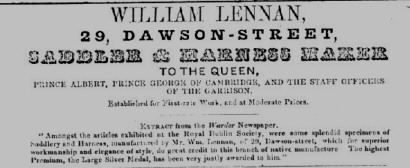
Lennan saddler, 1850
The move of William Lennan Jnr. to 29 Dawson St., the acquisition of the above properties by, or for, James and John Lennan suggest that William Lennan Snr. died about the year 1840 aged about 50 years and that there was a property share out between the brothers James and John, William Jnr. having been already provided for. The Dublin Directories for 1844 to 1860 show William Jnr. a saddler and James and John as boot and shoemakers. William Jnr. prospered in 29 Dawson St. and acquired No. 30 to enlarge his shop and subsequently added No. 32 (now the Royal Irish Automobile Club) as a livery stables. He brought his son William Francis (also a saddler), born 1841, into joint ownership in 1876. The period 1850-1890 was, it seems, the golden era of Lennan saddlery as proved by 1) the Royal Warrant, 2) the invention of the Lennan safety stirrup 3) the testimony to side saddles of Lennan manufacture contained in the "Book of the Horse" by S.Sidney and 4) the winning of the "Large RDS (Royal Dublin Society) Medal".
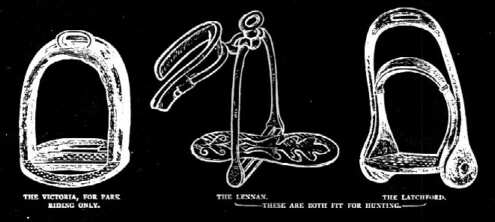
Latchford and Lennan stirrups for ladies
William Lennan Jnr. died about 1885 at 18 Brighton Square East, Dublin and the business was carried on by William Francis Lennan up to about 1900. His only child (a son) Francis J. entered the medical profession and, presumably, qualified in the early 1900's. It is not clear as to where and when William Francis Lennan died, as he appears to have enjoyed moving house. In Thom's Directories we find him at "Vista" Highfield Rd. Rathgar in 1865, at "Sylvan Lodge" Terenure 1868-1874, at Victoria Terrace Rathgar 1880-87, at 1 Rostrevor Terrace 1888, and finally at "Abbotsfort" Orwell Rd, Rathgar [Note: all locations in or around each other in Sth. Dublin suburbs]. In any event, the Dawson St. business ceased in the early 1900's, having been conducted for a period during, and after 1901, as a Limited Company under the title "Lennan Son & Co Ltd.", with Head Office at 29-30 Dawson St., Dublin and branches at 126 Donegal St., 15 Arthur Square and Union Street, Belfast.
James Lennan, son of Wm. Lennan (Snr.), born 1825 at 7 Pitt St., carried on his Boot & Shoemaking business for a year or two from 1840 at 7 Pitt St. and, thereafter, at 5 Pitt St. until 1866 and his son James Lennan Jnr., born 1840 [Note: doesn't really fit - child at 15] at 5 Pitt St. emerges in 1876 as a saddler conducting his own business from 27 Lr. Gloucester St. from 1876 to 1881. At some later date he became a teacher in saddlery at the Deaf and Dumb Inst. and lived at Francis St. for some time, later moving to 39 Patrick St. from which addresses he ran a Hardware shop from 1881 to the early 1900's. He had three sons, namely William, John (Jack) and Jimmy. All were saddlers. Little is known of Jimmy who joined the army and served in the Boer War. William abandoned the saddlery and worked in the Pavements Dept. of Dublin Corporation. John (Jack) carried on a saddlery business from Francis Street and eventually emigrated to Australia, he was unmarried [Note: 1996 information leads to a continuing Australian line, from James, son of the Francis St. saddler John who actually died in Dublin in 1922. In June 2000 contact was made with a descendant of a second son John who served in the Boer War, qualifying as a saddler at Woolwich in 1895].. William Lennan was born in Dublin in 1873 and died in 1957, leaving two sons James, born 1906, and Patrick, born 1907. James, a panel beater, was married and had three daughters and grandchildren and lives ..[in Dublin S.]. Patrick is also a panel beater and married a Miss Jordan, by whom he has two sons.... and a daughter.... They all lived..[in Dublin N., there being no male Lennan issue].
John Lennan born 1823 at 7 Pitt Street, son of William Lennan (Snr.) was a Boot and Shoemaker and carried on his business from 12 Merrion Row up to 1842. In 1843 he moved to 5 Mercer St. Lr., where he continued in business until 1854. In 1851 the Census [... population of Dublin 258000... rail link to Bray via Dundrum.... etc..] John Lennan, above referred to, had two sons, both being saddlers. Patrick J. born 1851 at 5 Mercer St., or 7 Pitt St., and John Lennan (Jnr.) born 1850 at 5 Mercer St., or 7 Pitt St.. Patrick J. carried on business at 23 O'Connell Street, Dublin (1874) and later at 34 Lr. Gloucester St. and, after that, at 38 Lr. Pembroke St. up to 1901. He had a son and a daughter, Willie and May, by his first marriage and, on the death of his first wife, married a much younger woman by whom he had three daughters, Annie, Kathleen and Josephine. It would seem that Willie and May left home and Patrick J. and his new family were residing at 15 Ely Place. May Lennan set up in business at Lr. Rathmines Road as "Lennan's Trunk Store" where she employed her brother Willie, a saddler by trade, to do general leather work. He remained a bachelor until his death. May married Eamonn Newth, had no children and continued to run her business until shortly before her death aged about 80 years in 1960.... I know nothing about the second wife and family.
John Lennan (Jnr.) born 1850 at 5 Mercer St. Lr. or 7 Pitt St. was reported to be in delicate health and was apprenticed to his uncle William. The story is that he was sent to the Nursing Home of a Mrs. Carroll at Williamstown (Dublin) where he subsequently met and married Miss Hannah Carroll, by whom he had three sons all born at Williamstown, James, Laurence and John (Jack), James being 5 years of age when his father died at Williamstown in 1879. Some 5 or 6 years later Hannah Lennan married a painter named George Austin, by whom she had two children, George and Bridget. George (Snr.) was a Protestant, but all the children were reared as R.C.. The Lennan boys, whose grandfather had the Mercer St. property, were duly apprenticed and became saddlers. It was a seven year apprenticeship and I assume they were bound to their Uncle, but I did hear a firm called "Box & Co." mentioned. Both Jack and James died in Abbeyleix and Mountmellick respectively, unmarried. Laurence, born 1876 died 1956 having had four children, Kathleen, Patrick, Mary and Laurence J.; Patrick and Mary died 17/5/23 and 21/5/43 respectively without issue. Kathleen died 10/7/73 leaving children and grandchildren. Laurence (Snr.) was, I believe, the last of the Lennan Saddlers of Dublin. He was foreman at the saddlery and harness making firm of O'Donoghue's of Wood Quay and, with the decline of the business, opened a saddlery and harness making shop at 19 Main Street, Donnybrook, continuing to satisfy an ever-decreasing demand until he died in 1956 aged 80 years. Laurence J. married and had a son Laurence K. and a daughter Mary G.. Both are married, Laurence K. having a daughter, Deirdre and a son Laurence D.. Mary G. has three [four] sons....
ANNEXES
ANNEX 1.
One specific Dublin Lennan male line
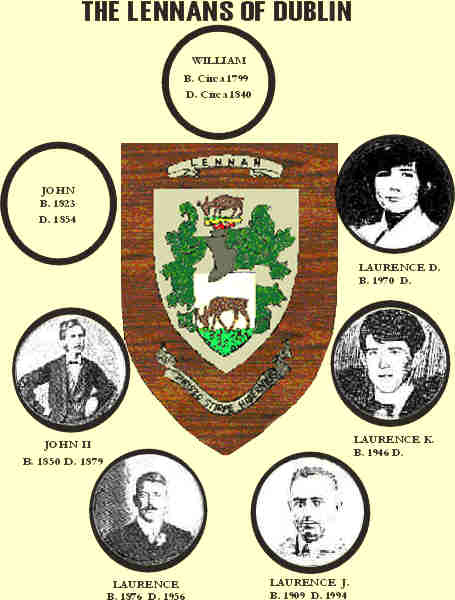
ANNEX 2.
Advertisement in the Dublin Directory of 1850 for William Lennan, 29 Dawson St, Saddler & Harness Maker to the Queen, Prince Albert, Prince George of Cambridge, and the Staff Officers of the Garrison, "Established for first-rate work at Moderate Prices", Extract from the Warder Newspaper. "Amongst the articles exhibited at the Royal Dublin Society, were some splendid specimens of Saddlery and Harness, manufactured by Mr. Wm. Lennan, of 29, Dawson-Street, which for superior workmanship and elegance of style, do great credit to this branch of native manufacture. The highest premium, the Large Silver Medal, has been very justly awarded to him.". [Photo in text]
ANNEX 3.
Data from old sources:
Griffith's Valuation 1854
No. Street Occupier Immediate lessor Description PLV
2 Pitt Street James Lennan (lodgers) James Lennan House & Yard £16
3 Pitt Street James Lennan (lodgers) James Lennan House & Yard £16
5 Pitt Street James Lennan Corporation of Dublin House & Yard £18
2 Mercer Street John Lennan (lodgers) John Lennan House & Yard £21
2 Mercer Street John Lennan (lodgers) Archdeacon C.Strong House & Yard £21
2 Mercer Street John Lennan John Lennan House & Yard £21
General Census 1901
Name Description Relig. Occupation Age Place of birth
Wm. Francis Lennan Head of family RC Retired Saddler 60 Dublin
Julia Lennan Wife RC Head & Wife 50 Exeter City
Francis J. Lennan Son RC Son 22 Co. Dublin
Mary Jane O'Keefe Servant CofI General Servant 45 Kilkenny
Patrick J. Lennan Head of Family RC Saddler & Harness maker 50 Dublin City
Kathleen Lennan Wife RC Head & Wife 35 Dublin City
Annie Lennan Daughter RC School 9 Dublin City
Kathleen Lennan Daughter RC School 8 Dublin City
Josephine Lennan Daughter RC School 6 Dublin City
Kate O'Shea Servant RC General Servant 19 Dublin City
Mary Tuite Nurse RC Nurse 30 Dublin City
ANNEX 4.
Extracts from the Book of the Horse, by S. Sidney, published by Cassell & Co. Ltd., p.327-328.
"The slipper-stirrup for side-saddles has been entirely discarded since the hunting-horn crutch was adopted. Three other forms of stirrup are in common use: - First , the ordinary pattern of a man's stirrup, with the inside of the ankle protected by padding. Secondly, the invention of Mr. Latchford, the celebrated London loriner, which is a stirrup within a stirrup, and releases the foot instantaneously in case of a fall. Thirdly, the invention of Mr. Lennan, of Dublin, which effects the same object in a different way" (see illustrations on p.327, [Photo in text]. Mr. Lennan's patent is most patronised in Ireland, Liverpool, Manchester, and Cheshire; Mr. Latchford's in London and the hunting shires. It has been objected to the latter that the second stirrup works loose after a time, and is apt to be lost on the hunting-field. This might be obviated by connecting it with the fixed stirrup by a cord strong enough to hold the inner stirrup, but not strong enough to resist a rider's weight. An eminent saddler has approved of this suggestion. No lady should venture into the hunting-field without a Latchford or Lennan stirrup.......Her Royal Highness the Princess of Wales rides habitually on the off side [right hand side], on a saddle without ornament (p.325) made by Messrs. Wilkinson and Kidd. Messrs. Langton, of Duke Street, Manchester Square, have made side-saddles a speciality; and Messrs. Bligh, of Park, have a great reputation. Excellent side-saddles are made by Mr. Lennan, of Dublin, and no doubt by many provincial makers in hunting counties."
ANNEX 5.
Photo of saddle plate showing royal warrant (circa. 1850-1888). (full image 39K). On p.983 of Webster's Royal Red Book, 1897, to be found on the Historical Directories site, a Prince of Wales' Warrant Holder is listed as 'Lennan & Son, Dublin'.
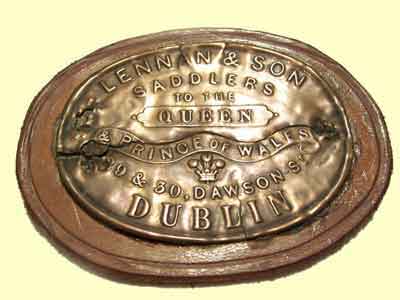
ANNEX 6.
Drawing of elevation of premises in Dawson St., Dublin [below]
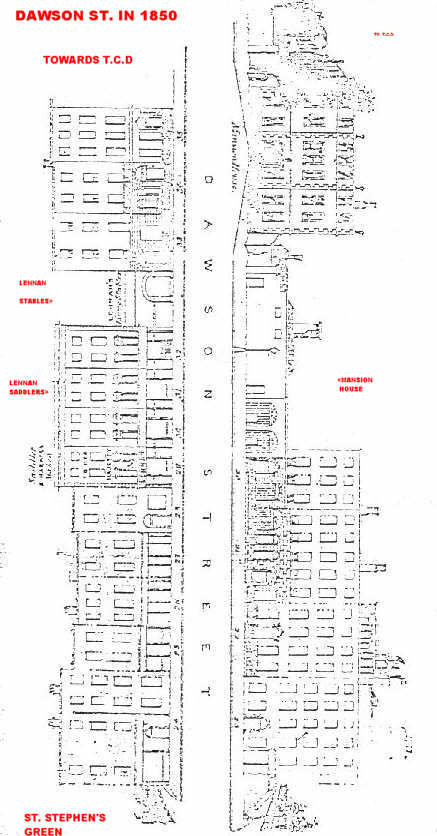

ANNEX 7.
Copy of correspondence with W.H.Gidden Ltd. London 1975 with illustrations of two Lennan stirrups [above].
ANNEX 8.
Futile correspondence in search of Parish records (SS. Michael and John) with comments [below].

*[Footnote: The above manuscript of my father forms the basis of my family research. Many of the early links are unproven, in particular the link with Dawson St. and other South City saddlers. It has now been established that my father's great-grandfather was a James, not John, as he had assumed, and is indicated in his illustration, now enhanced, and I have yet to establish that the family in the suburbs of South Dublin (Williamstown), although saddlers, had any link with those in the South City area. However, this was an era when profound demographic change was taking place, due to the coming of the first railway to Ireland, dealt with elsewhere in these pages]
SUPPLEMENTARY MATERIAL
L.Lennan Snr.: Saddler's invoice (full image 10K)
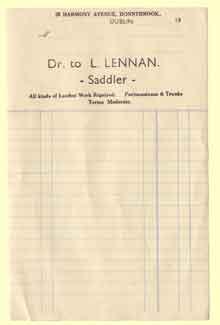
 Return to Lennan Index page, or go
to page 3, "Donnybrook, Dublin
South" for basic textual material.
Return to Lennan Index page, or go
to page 3, "Donnybrook, Dublin
South" for basic textual material. 
 Or go
to subpages of L*nn*n maps,
Glenn*n maps, historical data, GRO variants, manuscripts or Irish language pages.
Or go
to subpages of L*nn*n maps,
Glenn*n maps, historical data, GRO variants, manuscripts or Irish language pages.
 Or to
data for the index to Lenn*n
entries.
Or to
data for the index to Lenn*n
entries. 
![]() Alternatively, go to my
railwayana.com pages
for Irish railway data
Alternatively, go to my
railwayana.com pages
for Irish railway data ![]()
 Or even, go to my railwayana auction price pages
Or even, go to my railwayana auction price pages 